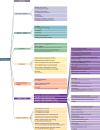Development of the NIH Patient-Reported Outcomes Measurement Information System (PROMIS) gastrointestinal symptom scales
- PMID: 25199473
- PMCID: PMC4285435
- DOI: 10.1038/ajg.2014.237
Development of the NIH Patient-Reported Outcomes Measurement Information System (PROMIS) gastrointestinal symptom scales
Erratum in
-
Corrigendum: development of the NIH Patient-Reported Outcomes Measurement Information System (PROMIS) gastrointestinal symptom scales.Am J Gastroenterol. 2015 Apr;110(4):608. doi: 10.1038/ajg.2015.62. Am J Gastroenterol. 2015. PMID: 25853211 No abstract available.
Abstract
Objectives: The National Institutes of Health (NIH) Patient-Reported Outcomes Measurement Information System (PROMIS(®)) is a standardized set of patient-reported outcomes (PROs) that cover physical, mental, and social health. The aim of this study was to develop the NIH PROMIS gastrointestinal (GI) symptom measures.
Methods: We first conducted a systematic literature review to develop a broad conceptual model of GI symptoms. We complemented the review with 12 focus groups including 102 GI patients. We developed PROMIS items based on the literature and input from the focus groups followed by cognitive debriefing in 28 patients. We administered the items to diverse GI patients (irritable bowel syndrome (IBS), inflammatory bowel disease (IBD), systemic sclerosis (SSc), and other common GI disorders) and a census-based US general population (GP) control sample. We created scales based on confirmatory factor analyses and item response theory modeling, and evaluated the scales for reliability and validity.
Results: A total of 102 items were developed and administered to 865 patients with GI conditions and 1,177 GP participants. Factor analyses provided support for eight scales: gastroesophageal reflux (13 items), disrupted swallowing (7 items), diarrhea (5 items), bowel incontinence/soilage (4 items), nausea and vomiting (4 items), constipation (9 items), belly pain (6 items), and gas/bloat/flatulence (12 items). The scales correlated significantly with both generic and disease-targeted legacy instruments, and demonstrate evidence of reliability.
Conclusions: Using the NIH PROMIS framework, we developed eight GI symptom scales that can now be used for clinical care and research across the full range of GI disorders.
Conflict of interest statement
Figures


References
-
- Wagner EH, Austin BT, Davis C, et al. Improving chronic illness care: translating evidence into action. Health Aff (Millwood) 2001;20:64–78. - PubMed
-
- Wagner EH, Austin BT, Von Korff M. Organizing care for patients with chronic illness. Milbank Q. 1996;74:511–44. - PubMed
-
- Marshall S, Haywood K, Fitzpatrick R. Impact of patient-reported outcome measures on routine practice: a structured review. J Eval Clin Pract. 2006;12:559–68. - PubMed
Publication types
MeSH terms
Grants and funding
- P30-AG028748/AG/NIA NIH HHS/United States
- P50 DK64539/DK/NIDDK NIH HHS/United States
- U01 AR052177/AR/NIAMS NIH HHS/United States
- 1 T32 AR053463/AR/NIAMS NIH HHS/United States
- AR052177/AR/NIAMS NIH HHS/United States
- P20 MD000182/MD/NIMHD NIH HHS/United States
- T32 AR053463/AR/NIAMS NIH HHS/United States
- P50 DK064539/DK/NIDDK NIH HHS/United States
- U01AR057936A/AR/NIAMS NIH HHS/United States
- P30 AG021684/AG/NIA NIH HHS/United States
- P30 DK041301/DK/NIDDK NIH HHS/United States
- P30-AG021684/AG/NIA NIH HHS/United States
- P30 AG028748/AG/NIA NIH HHS/United States
- K24 AR063120/AR/NIAMS NIH HHS/United States
- U01 AR057936/AR/NIAMS NIH HHS/United States
- 2P20MD000182/MD/NIMHD NIH HHS/United States
LinkOut - more resources
Full Text Sources
Other Literature Sources
Medical
Miscellaneous

